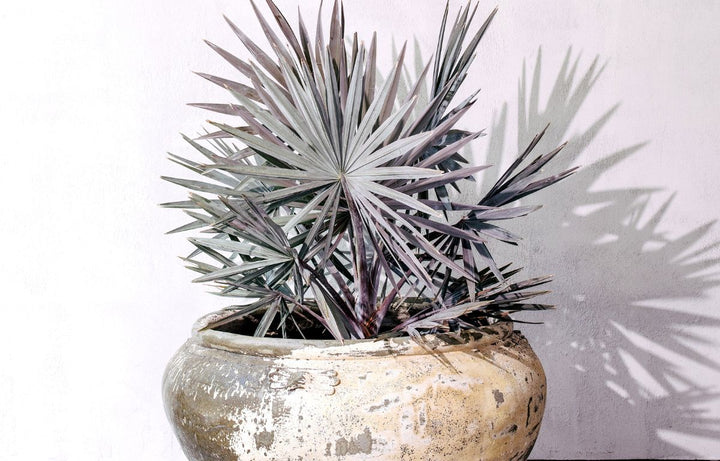
Plant Profile: Bismarck Palm
Plant Profile: Bismarck Palm
The Bismarck Palm Bismarckia nobilis is a striking and majestic tree native to Madagascar. Known for its impressive size and silvery-blue fronds, it has become a popular choice for gardeners and landscapers in tropical and subtropical regions.

The Bismarck Palm hails from the island of Madagascar, where it thrives in the arid, tropical climate. It is named after the German Chancellor Otto von Bismarck. This palm is well-adapted to hot, sunny conditions and is known for its drought tolerance, making it an ideal choice for warm climates.
The Bismarck Palm is renowned for its grand appearance, with impressive key features. It can grow up to 18 meters tall with a spread of up to 6 meters with an average lifespan of 30-50 years. The large, fan-shaped fronds can reach up to 3 meters in diameter and are typically a stunning silvery-blue colour, though a green variety exists. The trunk is thick and sturdy, with a greyish colour and a slightly rough texture. Additionally, the palm can produce small, inconspicuous flowers followed by dark brown, spherical fruits when grown in optimal conditions.
Care and Maintenance
Growing a Bismarck Palm indoors presents unique challenges due to its size and light requirements but it is not impossible, especially when grown in cooler climates.
Light: The Bismarck Palm thrives in full sun, which can be difficult to provide indoors. Place it in the brightest spot available, such as near a north or north-westerly-facing window. Supplemental grow lights can help meet its light needs.
Watering: Water the palm regularly but allow the soil to dry out between waterings to prevent root rot. Ensure the container has good drainage.
Humidity: Bismark Palms prefer moderately high humidity levels between 40-50%. Indoor environments often lack the ambient humidity the palm prefers. Increase humidity by using a humidifier or place the palm near other plants.
Temperature: Keep the palm in a warm environment, avoiding cold drafts and air conditioning vents. Ideal temperatures range from 18°C to 29°C. The Bismark Palm greatly benefits from being moved outdoors on warm sunny days. Not only does this allow for direct light exposure but promotes healthy air circulation.
Fertilisation: Use a balanced, slow-release fertiliser in warmer seasons, applied sparingly. As the Bismark Palm is a slow-growing plant, over-fertilising can be detrimental.
Pruning: Pruning should be sparing and only to remove dead or yellowing fronds to maintain the plant's health and appearance.

Problems and Solutions
Pests: Common pests include scale insects and spider mites. Treat infestations with insecticidal soap or neem oil. Regular inspection can help catch and address pest issues early.
Diseases: The Bismark Palm is susceptible to slow-acting wood fungal diseases like Ganoderma butt rot. Ensure good drainage and avoid overwatering to reduce the risk of fungal infections. If infected, isolate the Bismark Palm if it is housed with other plants and apply fungicide treatments immediately. Prune away any infected areas to stop the spread to healthy parts of the plant.
Nutrient Deficiencies: Faded or yellowing fronds can indicate a nutrient deficiency, often of magnesium or potassium. Use a palm-specific fertiliser to address deficiencies if unsure.
Cold Sensitivity: The Bismarck Palm is sensitive to cold temperatures. If you live in an area prone to frost, protect the palm during cold snaps by covering it with a frost cloth or moving container-grown palms indoors to prevent the fronds from forming yellow or brown patches.
Slowed Growth: The Bismarck Palm is naturally a slow-growing plant due to its extensive root system development, which prioritises stability and nutrient absorption over rapid expansion. Unusually slow growth or limp fronds can be attributed to a lack of sunlight. Move the palm into a sunnier position or use grow lights to supplement or extend the exposure in times of the year with overcast or shorter days.
While growing a Bismarck Palm indoors presents certain challenges due to its size and light requirements, it is not impossible with the right care and conditions, especially when grown in cooler climates. Either way, the Bismarck Palm is a unique plant offering a dramatic focal point with its stunning fronds and robust stature adding a touch of tropical magnificence to any space.
